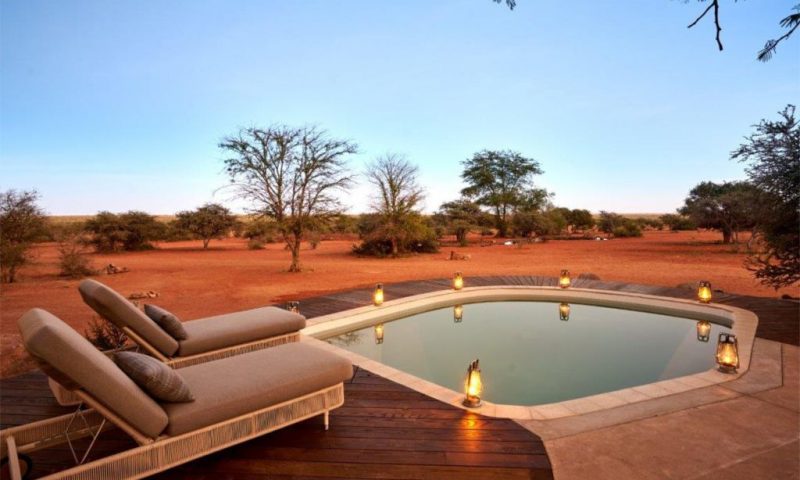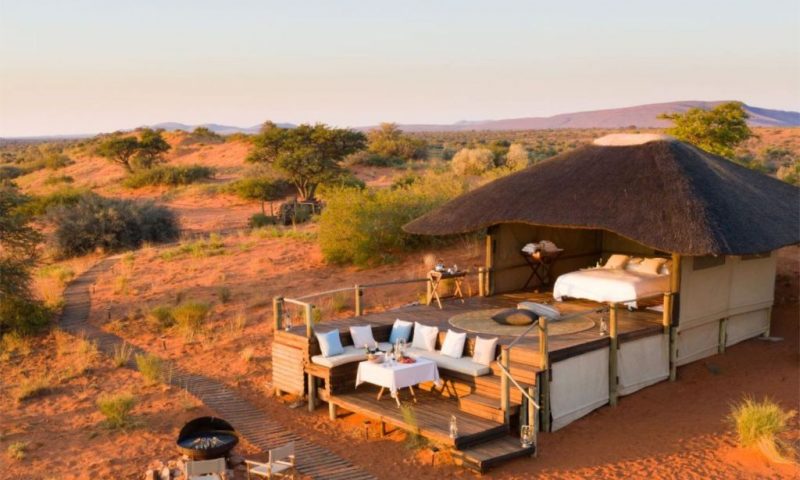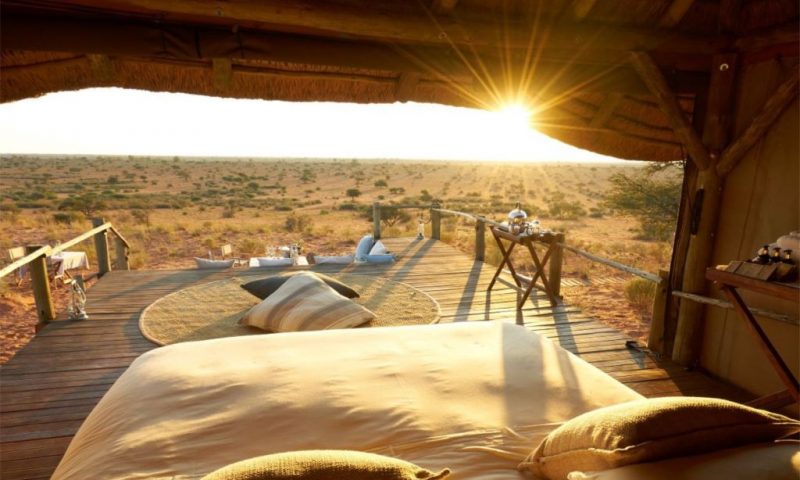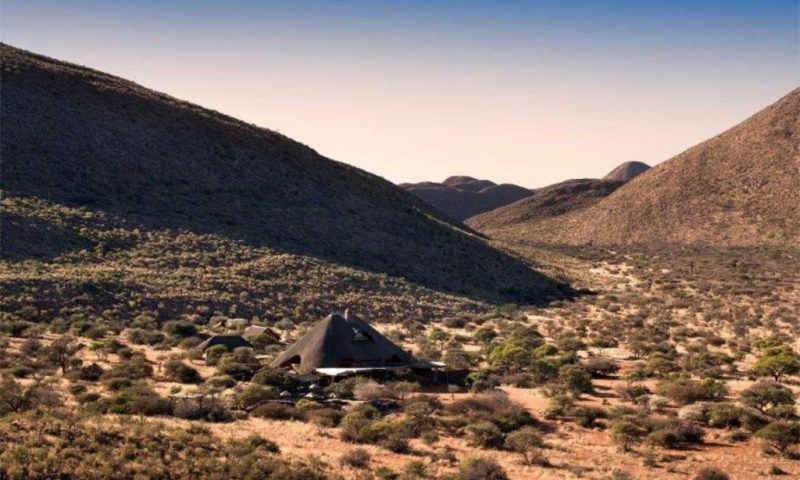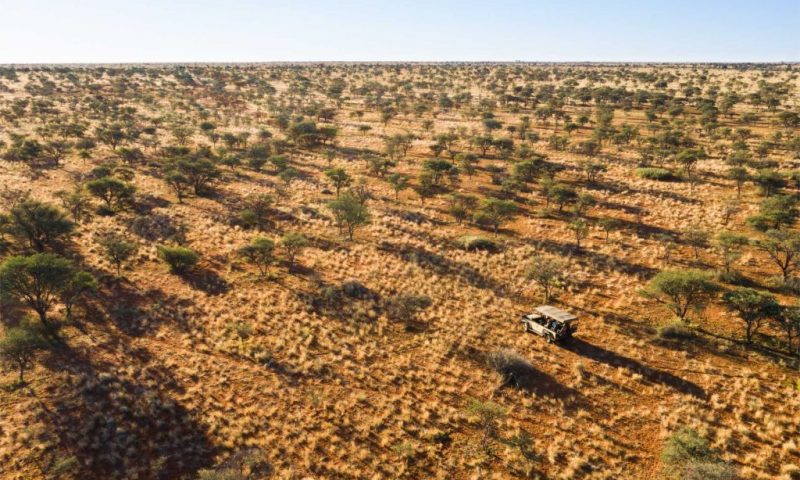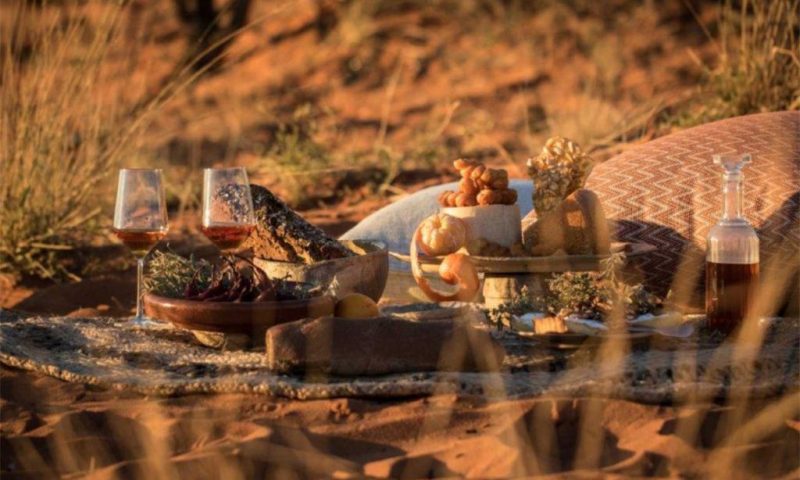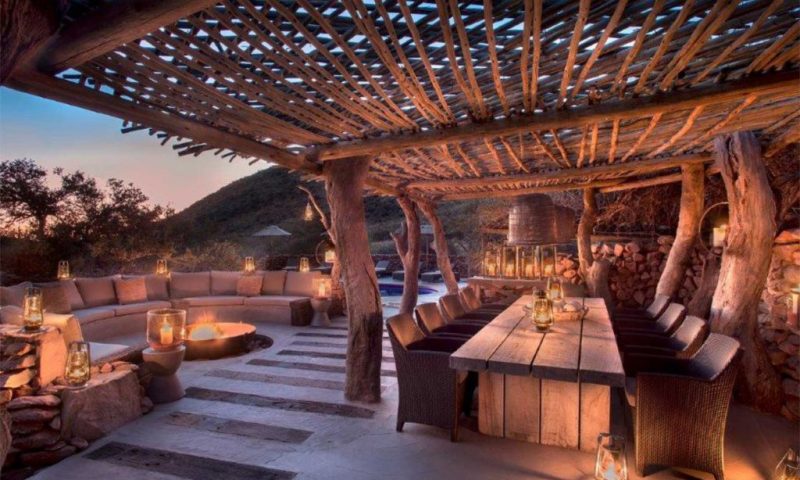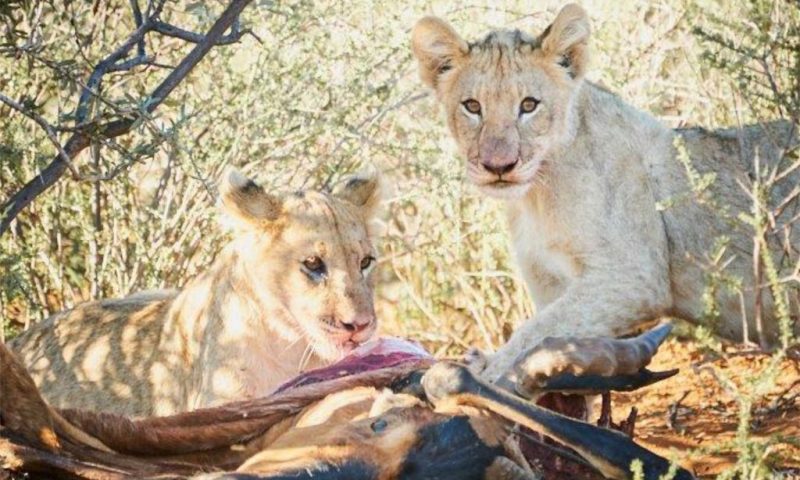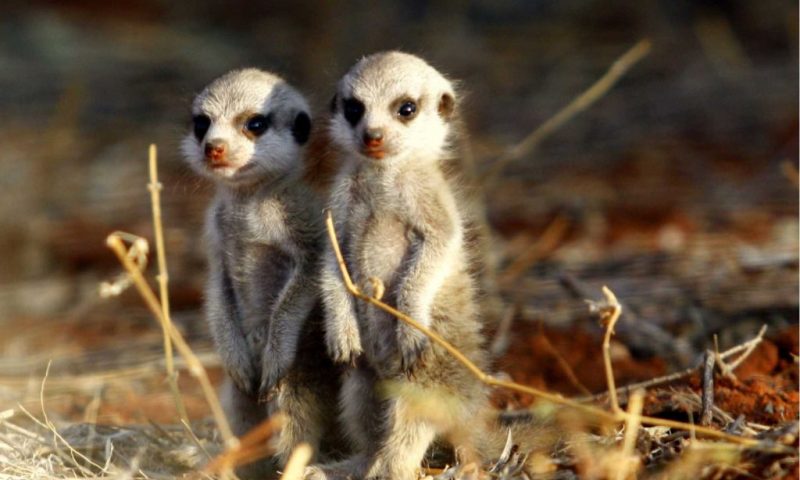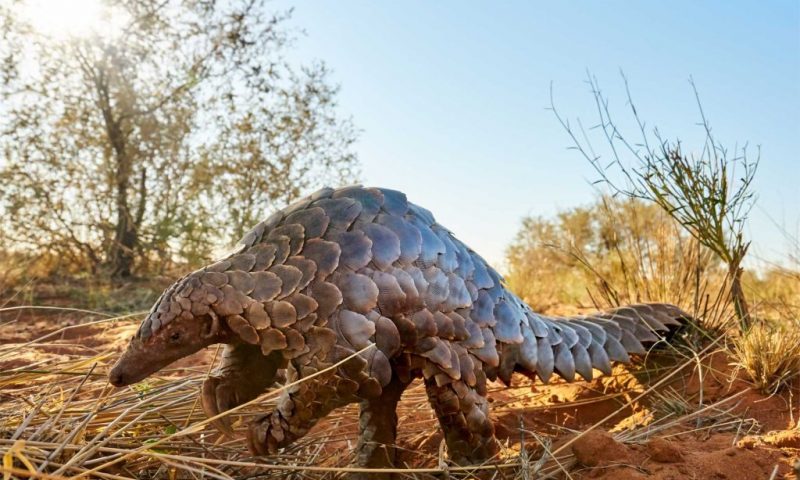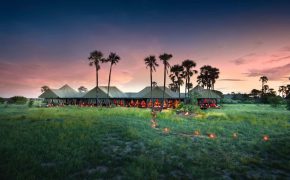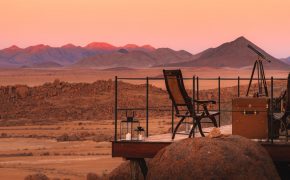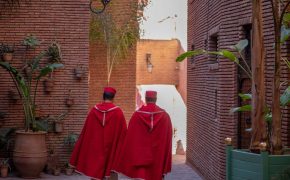Tswalu is a vast, magical land of infinite possibility, with sweeping vistas and a liberating sense of space. The green Kalahari is nature at its most diverse and surprising, and to spend time here is to be touched by exuberant, soulful beauty.
Considered important for thousands of years, we’re now striving to conserve this breath-taking landscape for future generations.Tswalu lets you reconnect with the richness of the earth. It offers an escape to a place that’s governed by the ancient rhythms of the seasons, rather than the clock and the calendar.
It offers a vision of hope that brings together conservation, research and unrivalled safari experience. Everything we do is centred around our creed: To leave our world better than how we found it.
At Tswalu, there are only two camps and you’ll be one of just 28 or fewer guests. Enjoy the privacy and exclusivity that define contemporary luxury – and experience the Kalahari at your own pace.
OUR CAMPS
As South Africa’s biggest privately owned game reserve, Tswalu has an extremely low ratio of guests to space. This low-impact approach to ecotourism means that you’ll be one of no more than 28 guests with exclusive access to one of southern Africa’s last great wildernesses.
The reserve is serviced by a private, hard-top airfield, and on arrival you will be welcomed at the foot of the aircraft stairs by your personal field guide and tracker who will take care of you for the duration of your stay, arranging every aspect of your private safari.
Privacy, exclusivity and flexibility have always been central to the Tswalu guest experience, from dining and down time to the diverse safari activities, from interpretative walks and horse riding to spending time in the field with one of the research teams from Dedeben Research Centre, which falls under the Tswalu Foundation.
Your Tswalu adventure begins in one of our two luxury camps, the Motse or Tarkuni. The Motse is a luxury camp with nine private guest legae (Tswana for ‘home’); three are specifically for families, with two bedrooms.
Tarkuni, located in a secluded valley below the Korannaberg mountains, is a private homestead with five bedrooms for the exclusive use of a multigenerational family or a party of friends.
Located far apart, both camps are perfectly positioned to take in the wide, open spaces that are so typical of the southern Kalahari’s dramatic beauty. By choosing to stay in one of these small, luxury camps, guests are contributing towards the conservation of the southern Kalahari’s biodiversity.
THE MOTSE
At the foot of the Korannaberg mountains, the Motse is a luxury, contemporary camp with nine private guest legae, the Tswana word for ‘home’. The entire camp, including the main lodge’s indoor and outdoor lounge and dining areas, echoes the Kalahari’s dramatic beauty with richly textured interiors in soothing nature-inspired tones.
The Motse welcomes children of all ages, and families are accommodated in one of three two-bedroom legae with a central living room. Inspiring adventure while soothing the senses, the Motse is your home from home – comfortably luxurious, yet comfortingly familiar.
TARKUNI
Tarkuni is Tswalu’s private homestead for multi-generational families or a celebratory reunion of friends. Located in a secluded valley below the ancient Korannaberg mountains, it offers the ultimate, exclusive-use escape and the opportunity to pause and appreciate the immense luxury of space that defines the southern Kalahari and Tswalu.
With accommodation for up to 10 guests in five suites, all the pleasurable daily rituals of safari living have been thoughtfully considered and sustainably designed.
Along with a smaller, more environmentally friendly plunge pool, lovely new spaces have been created for outdoor dining and relaxation, including an intimate boma with low, stone-packed walls for magical fireside barbecue dinners under the stars as well as breakfast or lunch with uninterrupted views.
DINING
Dining at Tswalu is rooted in local heritage and cultural diversity and has become an integral part of our sustainability journey. In the kitchens of the Motse, Tarkuni and Restaurant Klein JAN, with every recipe and every menu our chefs are continually adding to the culinary story of the southern Kalahari and the Northern Cape.
Every taste is a reminder of South Africa’s rich culinary heritage, interpreted in a fresh, modern way. Creating a refined, seasonal dining experience in the middle of a vast, remote reserve – food that also has an authentic sense of place – requires resourcefulness, creativity and team work.
Almost everything is made from scratch. Our chefs, under the capable mentorship of executive chef, Marnus Scholly, are developing a pioneering, sustainable food culture in close collaboration with chef Jan Hendrik van der Westhuizen.
Jan retains a Michelin star for Restaurant JAN in Nice, France, which opened in 2013. His vision of developing a sustainable food culture at Tswalu now finds expression at Restaurant Klein JAN, where a seasonal tasting menu celebrates the best of the region on the plate.
Whether out on a game drive, tucking into a picnic lunch or enjoying a barbecue dinner in the dunes, our food is consciously grounded in ethically sourced, regional produce sourced from dedicated, passionate farmers, artisans, makers and producers of all things edible from goat’s milk cheeses and nutritious, organic grains to camel milk and pasture-reared beef and lamb.
The Northern Cape is also known for its pecans, pistachios, dates, citrus, grapes and dried fruits. The region’s surprising bounty include bottles from boutique, family owned wineries, adding to the depth of wines on our award-winning wine list, as well as small-batch craft brandies, gins and other typically South African spirits and liqueurs.
At Tswalu, dining is not confined to regular mealtimes but is part of almost every experience and food and drinks are there to be enjoyed at any time.
From private dining on your veranda to a barbecue in the boma, dining often takes place outdoors to take advantage of the wonderful climate and the endless views. In addition, guests of the Motse camp and Tarkuni homestead are invited to experience one memorable meal at Klein JAN during their stay.
WELLNESS
Our skilled spa therapists are here to work their magic with reviving face and body treatments in the cool, calm sanctuary of one of two treatment suites at the Motse or in Tarkuni’s private, upstairs spa suite.
At both camps, massages, manicures and pedicures can also be arranged in the privacy of your bedroom or outdoors on the veranda. Treatments are available at any time, even in the evenings.
The spa uses two proudly South African, eco-conscious product ranges, Katavi and Just Pure, in line with Tswalu’s ethic of sustainability and vision to leave the world better than how we found it. Flooded with natural light, the gym at the Motse is air-conditioned and equipped with Technogym apparatus, free weights and a mat area for stretching, pilates or yoga.
While completing a workout or adding an indulgent or therapeutic treatment to your safari is a wonderful way to bring body, mind and spirit into balance, wellness at Tswalu extends beyond the spa and gym.
The rhythm of safari life, whether on or off the vehicle, facilitates a deep engagement with the awe-inspiring, vast landscapes of the southern Kalahari, sharpening the senses and reawakening our need to reconnect with nature and benefit from its healing power.
ROMANCE
Going on safari is undeniably romantic, whether celebrating a honeymoon, marking a relationship milestone or simply needing to rekindle your love.
Tswalu is designed to seduce, from the southern Kalahari’s dramatic landscapes and wide, open spaces to the endless opportunities for private dining, from the unique culinary adventure that is Restaurant Klein JAN to a lantern-lit dune dinner under a starry sky.
The guarantee of a private vehicle, with a personal guide and tracker, adds to the exhilarating sense of freedom, exploring the reserve at your own pace and never having to share animal sightings with other guests.
Activities, like horse riding or taking a guided hike in the foothills of the Korannaberg, followed by a picnic breakfast in the shade of a camel thorn, all add up to the trip of a lifetime.
FAMILY
A family safari is a great shared adventure, and an opportunity to strengthen family bonds and create lifelong memories. Whether learning the art of tracking, identifying animals, or finding the Southern Cross in the night sky for the first time, a safari with children is very special.
Young eyes are opened to a completely different world, where the realities of sharing space with wild animals necessitates taking certain precautions and learning about bush lore.
Children of all ages soon become immersed in the outdoor classroom that is Tswalu, where the guide and tracker become the teachers and learning about the importance of conservation is not only educational but great fun.
The advantages of having a private safari vehicle, guide and tracker are particularly relevant for families, and children of all ages are welcome on game drives. Tswalu is in a malaria-free region of South Africa, making it extra safe for a family safari with a baby or young child.
ACCOMMODATION
Three of the Motse’s legae are ideal for families, comprising a main bedroom and a second bedroom with twin beds, both with their own bathrooms and outdoor showers, and a central living room with a wood-burning stove. All rooms lead onto a shaded veranda for outdoor dining, lounging and game viewing.
For larger families or multi-generational groups, the exclusive-use Tarkuni homestead accommodates up to 10 guests in five bedrooms, all under one roof.
ACTIVITIES
Days on safari are individually planned for each family, from drives and walks to dining and down time. The duration and scope of each activity, on and off the vehicle, will depend on the age and special interests of your children.
Other activities include bush walks, picnics, horse riding, pizza making and cookie baking. Our Junior Ranger programme includes archery, spoor identification and casting, and learning how to track animals.
DINING
Whether dining together as a family in the main camp or preferring to dine privately in your legae, our chefs are on hand to make meal times easy and relaxed. Like everything else about your Tswalu safari, our approach to family dining and wellness is very personal.
Our chefs can make almost anything, especially if ordered in advance, from fresh fruit and vegetable purees for babies through to homemade burgers and fries and pizza for older children.
TAKE A PHOTOGRAPHIC SAFARI
The summer months at Tswalu are a photographic safari delight. It’s when the region is often referred to as the Green Kalahari as rainfall transforms the vast landscapes rolling away to the horizon below dramatic skies.
Clouds soften the light, the days are longer and there is less dust. For high-drama wildlife photography, the dry, winter months yield incredible, often up-close sightings as the animals are drawn to water sources. With less vegetation, visibility increases too.
Whatever the season, Tswalu is always a wonderful place to get creative with a camera.Whether photographing the southern Kalahari’s iconic landscapes or its wildlife, taking the shot of a lifetime requires patience and time.
The undivided attention of a guide, who combines a deep understanding of animal behaviour with slick photography skills, and who knows just how to manoeuvre the vehicle into the right position for the perfect capture, is highly advantageous.
While Tswalu guarantees a private vehicle and dedicated, experienced guiding team with every booking, those who are really serious about taking wildlife photos will appreciate the introduction of a fully equipped photographic safari vehicle and specialist guide.
Vehicle specifications
Like all Tswalu’s safari vehicles, the modified vehicle is a Land Rover. It’s geared to meet the needs of a solo photographer, but has plenty of space for a second guest. A rotating swivel seat allows for an uninterrupted, 270-degree arc and can be locked into position.
The seat is fitted with a stabilising arm and platform for taking sharp, steady images, even with a long lense. There are also brackets, slings and bean bags to assist with stability and sharpness. Hatches cut into the sides of the Land Rover afford the photographer the opportunity to lie flat on a firm mattress to photograph animals at eye level.
Equipment to hire
Tswalu has already purchased two 150 – 600mm ‘Sigma Contemporary’ zoom lenses, compatible with Nikon or Canon mounts, and will expand the available range depending on demand. Requests for other lenses can be arranged in advance.
Who will benefit
‘The idea is for all levels of photographers to get their best shots,’ explains Gus van Dyk, Tswalu’s head of conservation. ‘Novices will benefit from some guidance on the basics, and experienced photographers will benefit from the photo opportunities that present themselves while spending time with an experienced guide.’
Learning the basics
Those new to wildlife photography can learn the basics of photography, such as exposure, composition, selecting a suitable shutter speed, and depth of field, and then put their new skills to work shooting in different conditions. There is no limit to the length of drives on Tswalu, so guests can stay out for as long as they want.
Perfecting the art
Experienced photographers will appreciate the opportunity to spend as long as it takes to get a great shot. There is no queuing for sightings at Tswalu, so a patient photographer can wait for either the best light or to catch the behaviour they are after.
On-site photographic studio
Guests can learn to edit, tweak and print their best images in The Motse’s Photographic Studio. Editing is done in Adobe Photoshop or Lightroom, and printing is available up to A1 size on either paper or canvas.
Good to know
Every guest vehicle has a pair of Zeiss Terra ED 10X42 binoculars on board for guests to use while they are out on safari. A range of the finest Zeiss binoculars are also available to purchase from the studio.
Advance booking
Both the vehicle and specialist guide are available at an additional cost and need to be booked in advance.
EXPERIENCE TSWALU
From the ancient quartzite Korannaberg to the southern Kalahari’s grassy, red sand dunes rippling away to the horizon, Tswalu offers what travellers want most – time and space.
Tswalu is South Africa’s largest privately owned game reserve, and its wide, open spaces have long drawn travellers seeking a deeply layered, immersive safari where time is elastic and days unfold at a slower pace.
It is a place for nature lovers, who value privileged access to this vast, remaining tract of wilderness far more than conventional notions of luxury. With all this space comes the exclusivity of a private vehicle, guide and tracker, providing the freedom and flexibility to choose where to go and what to see.
It also means unlimited time at sightings, which may include some of the elusive species that find sanctuary here, such as aardvark, pangolin and brown hyena. Tswalu is also known for sightings of iconic Kalahari species like the oryx, desert black rhino, black-maned Kalahari lion, cheetah, and wild dog.
The southern Kalahari’s vast, dramatic landscapes are balm for the soul, and we encourage you to stay a little longer to experience everything that Tswalu has to offer.
Take long drives with your private guide and tracker to find some of the iconic, elusive or endangered animals that define this place, walk in the foothills of the Korannaberg and marvel at ancient rock art, join one of the Tswalu Foundation’s researchers in the field, observe the sociable antics of foraging meerkats, or head over the dunes on horseback for a picnic lunch or a night in one of our star beds.
By staying longer at Tswalu there is also more time to enjoy the generosity and abundance of being a special guest in one of our beautiful camps, from private dining experiences in surprise locations to restorative face and body treatments in the spa.
The addition of Restaurant Klein JAN to the reserve, its seasonal tasting menu rooted in local provenance and regional specialities, celebrates the Northern Cape’s heritage and culture as part of Tswalu’s greater journey towards sustainability.
SAFARI
The notion of what it means to journey has been redefined and recalibrated. At Tswalu there is time to slow down and be more mindful of our imprint on the earth and the many miracles unfolding all around us in nature.
With conservation at its core, Tswalu offers privileged access to one of the last remaining true wilderness areas in South Africa. As our guest you become part of our vision to leave our world better than how we found it.
Days on safari at Tswalu unfold at your own pace, depending on your interests and the time of year. With every Tswalu booking, a private vehicle, guide and tracker is guaranteed. With this comes the freedom and flexibility to choose where to go and what to see on the reserve. Nothing is dictated, and the only schedule is your own.
Each drive or activity, such as a starlit dune dinner or Naledi sleep-out experience, becomes part of your exclusive, personalised Tswalu safari. Just like the sands of the Kalahari, we understand that your priorities may shift during your time at Tswalu. That’s why we’ll never try and shoehorn your experience into a fixed schedule.
Unlike most private reserves in South Africa, there are no other lodges on the property and the land is not shared with guests from other concessions or properties. This means that there are no areas of the reserve that are off-limits to guests. Heading off in a new direction every day, it literally feels as if you have the entire southern Kalahari to yourself.
Scenic helicopter flights, nature walks, rock art excursions, time in the field with one of the scientists from Dedeben Research Centre, or a session in the photographic studio, editing and printing your best wildlife images, are a few of the other specialised activities on offer.
Tswalu is malaria free, making it an ideal safari destination for families. Children are actively encouraged to participate fully in the safari experience.
SAFARI EXPERIENCES
No two Tswalu experiences are the same. That’s because the way you see and touch this magical place will be shaped by your particular interests and will happen at your own pace. Tswalu is a generous landscape and as the sun rises above the Korannaberg mountains each morning, new opportunities to learn, play and explore come to life.
SAFARI TEAM
The advantages of having a private vehicle and dedicated guiding team to explore this vast, private reserve are hard to quantify. Freedom, choice and time on safari are yours to relish and remember. Experienced and committed, our field guides and trackers all chose different routes to reach the Kalahari.
What unites them is a shared passion for nature, conservation and Tswalu’s wide, open spaces. These men and women are here to interpret and unravel the mysteries and fascinating details of the southern Kalahari ecosystem, along with daily wildlife sightings and photographic highlights.
Experienced and committed, our field guides and trackers all chose different routes to reach the Kalahari. What unites them is a shared passion for nature, conservation,
Tswalu’s wide, open spaces and a deep commitment to interpret and unravel the mysteries and fascinating details of the southern Kalahari to share with their guests. Their enthusiasm is infectious, and they are true ambassadors for the restoration of the grasslands and dunes of this vast, magical land.
PRIVATE VEHICLE SAFARI
A private vehicle allows for unlimited time at sightings, which may include some of the elusive species that find sanctuary here, such as aardvark, pangolin, bat-eared fox, brown hyena, and aardwolf. Other iconic Kalahari species include the black-maned Kalahari lion, the desert black rhino, wild dog, oryx and cheetah.
At any time of the year, there are special sightings and transformations to the landscape influenced by seasonal changes and the absence or abundance of water. Spending time at one of the habituated meerkat colonies is often a highlight of a Tswalu safari.
MEERKAT EXPERIENCE
An early morning visit to Tswalu’s habituated meerkats to see them in their natural habitat is an unforgettable encounter.
Guests have the opportunity to get within a few metres of one of three habituated family groups to watch them pop in and out of their burrows, stand sentry, groom and play with each other, soak up the sunshine, and forage in the sand for tasty morsels. The families are referred to as the Mokala, Gosa and Rockstar groups.
The Tswalu meerkat experience is made possible because these sociable creatures have been habituated over many years to accept humans as part of their environment and not to see our presence as a threat or danger.
Habituators have spent many hours in the presence of each of these groups to build their trust. It is a very slow process of moving closer or retreating to give them more space, all the time observing their behaviour. The animals are not followed when they move beyond the safety of their burrows to forage to ensure that their feeding habits are not disrupted.
Your guide will wake you at daybreak, because the best time to see the meerkats is when they first emerge from their burrows to scan the horizon, groom themselves in the sun and begin foraging for the day.
For the best experience guests should sit as still as possible, about two metres away, and just observe the meerkats going about their normal activities. It is an encounter that will bring you up close to wild animals and immerse you in their natural environment.
HORSE RIDING SAFARI
Another wonderful way to appreciate Tswalu’s landscapes and wildlife is from the saddle. A guided horse safari allows up-close animal sightings that are sometimes not possible from a vehicle or on foot. Horse riding is a magical way of experiencing nature, regardless of your level of experience.
The stables at Tswalu have well-schooled horses to suit everyone, from beginner level to expert rider. Follow game trails through the grasslands, head over the dunes for a picnic lunch in a quiet spot or ride across the reserve to watch the sun set and spend the night in the Malori star bed.
Bond with Tswalu and our specially trained horses and gain a different perspective as you follow game trails on horseback. A Tswalu horse riding experience is not about speed, but about gently exploring dry savannah and seasonal riverbeds and seeing the land anew from within the herd.
HELICOPTER SAFARI
Viewing Tswalu from the air puts everything into perspective, and is one of the best ways to appreciate the sheer scale of the southern Kalahari. Tswalu’s undulating dunes and expansive grasslands are punctuated by the Korannaberg, a mountain range that contributes to greater habitat diversity than elsewhere in the Kalahari.
BIRDING SAFARI
Birders will be eager to discover many of the bird species of the southern Kalahari while at Tswalu. Birding is best done on foot. Setting out in the early morning on a walking safari coincides with the onset of the dawn chorus. Listening to bird calls is always a useful tool to locate different birds.
Early risers include the robust and vocal White-browed Sparrow Weaver (Plocepasser mahali) with its series of chattering and squealing phrases. Cutting through the cool of the morning are the high-pitched, melodious whistles of the Kalahari Scrub Robin (Erythropygia paena).
The rocky foothills of the Korannaberg, where pungent Lavender Fever Berry bushes (Croton gratissimus), shrub-like trees and numerous grass species grow, provide habitat for the elusive and shy African Rock Pipit (Anthus cinnamomeus).
Its repetitive and sometime monotonous ‘wheeee-prrrreeeeeu’ call gives it away. It’s also the place to be on the look out for the polymorphic and variable Mountain Wheatear (Oenanthe monticola). The African Red-eyed Bulbul (Pycnonotus nigricans) is often perched on top of a tree, sunbathing in the early morning rays, in these foothills.
Where the quartzite mountains meet the Kalahari’s red sands, larger trees can be found. Buffalo-thorn tree (Ziziphus macronata), which have countless uses based on traditional beliefs, provide shelter and food for both ground-dwelling and arboreal species.
The White-backed Mouse bird (Colius colius) and Cape Glossy Starling (Lamprotornis nitens) are both attracted to the sweet reddish fruits during the summer months.
The striking Yellow Canary (Crithagra flaviventris) is a colourful species to tick off the list, but listen carefully for the ‘preep-preep-preep’ cricket-like trill of the Barred-Wren Warbler (Calamonastes fasciolatus), which uses contact-calling while moving through the woodlands.
Keystone tree species, such as the complex Camel thorn tree (Vachellia erioloba), are large and strong enough to support the enormous Sociable weaver (Philetairus socius) nests which can be built to exceed one ton in weight.
Sitting patiently under one of these community nests may be rewarded with a close-up of one of the smallest diurnal raptors in the region, the Pygmy Falcon (Polihierax semitorquatus). The Pygmy falcon makes use of one of the many chambers of the Sociable weaver’s nest.
Dotted around the vast plains are Shepherd’s trees (Bosica albitrunca) with their distinctive whitewashed bark. These large trees provide the perfect spot for birds like the Golden-tailed woodpecker (Campethera abingoni), which creates a five-centimetre wide hole in a large branch or trunk in which to build its nest.
These nests are later used by other species, such as the Acacia Pied barbet (Tricholaema leucomelas) or the Pearl-spotted owlet (Glaucidium perlatum).
These treed areas are also favoured by the Southern Yellow-billed Hornbill (Tockus leucomelas), which moves from tree to tree with bouts of flapping and gliding.Silver Cluster leaf trees (Terminalia sericea), which provide cool cover for multiple species at rest, are typical of the ancient and undulating dune fields.
The dune streets are dominated by a tangled mess of Three-thorn shrubs (Rhigozum trichotomum) while grass species run up and over the crests of the dunes. Groups of up to 20 Scaly-feathered finches (Sporopipes squamifrons) are a typical sight in the tangled undergrowth, while the melodious whistles and canary-like trills may give away the location of a Fawn-colored Lark (Calendulauda africanoides).
Where the topography changes again, becoming fairly flat with a slight undulation, grassy plains of Gha grass (Centropodia glauca) and Giant three-awn (Aristida meridionalis) dominate with scattered Grey Camel Thorn trees (Vachellia haematoxylon).
The harsh, rather raucous call of the Northern Black Korhaan (Afrotis afraoides) is often heard, and the prehistoric-looking Kori Bustard (Ardeotis kori) is regularly seen moving through the vegetation in search of large insects.To the west, water pans attract flocks of up to 50 birds at a time, sometimes circling several times before landing.
Burchell`s Sandgrouse (Pterocles burchelli) and Namaqua Sandgrouse (Pterocles namaqua) use these pans for a quick drink an hour or two after sunrise. Some flocks fly up to 60 kilometres in a day to access water sources like these pans.
Namaqua Doves (Oena capensis) and Ring-necked Doves (Streptopelia capicola) are also frequent visitors to the life-giving water.
Set in open landscape, these busy pans provide ideal hunting conditions for birds higher up on the food chain, such as Red-necked Falcon (Falco chicquera), Greater Kestrel (Falco rupicoloides) and Gabar Goshawk (Micronisus gabar).
Whether wandering over rocky hills, strolling through grassy plains, cresting a red sand dune or just waiting it out at a watering hole or pan while sipping on coffee, birding on foot is always a rewarding way to spend a morning on the reserve
STAR BEDS
If you have been craving the solitude and silence of nature, raw and unfiltered, camping out for the night in one of our two star beds, the Naledi or Malori, will add an exciting dimension to your safari. Once dusk fades into velvety darkness, the sounds of nocturnal animals and a sky full of brilliant stars will be the only distractions.
Choose Naledi, an elevated, open-air platform in the south, or reserve a night at the Malori, a romantic safari tent overlooking the savanna dunes to the west.
NALEDI
Meaning ‘star’ in the local Tswana language, Naledi is a simple sleep-out deck in the Korannaberg mountains. Elevated above a valley with mesmerising views, Naledi is for those who want to experience what it’s like to sleep under the stars out in the open.
Equipped with stretcher beds and plenty of warm layers for chilly nights, the deck has a private, open-air bathroom. Nothing detracts from its private and remote setting in the south of the reserve.
A night at Naledi is an optional activity that is included in your stay. It does not need to be booked in advance, but is offered subject to availability and prevailing weather conditions. Children over the age of 12 are welcome at the discretion of the guide.
MALORI
The Malori, which means ‘dreamer’ in Tswana, puts the magical African night sky and the southern Kalahari wilderness within reach, without having to stray too far out of your comfort zone.
This is a fully equipped safari tent on a raised platform, positioned to take in the savanna dunes rolling away to the west and the purple, velvety softness of the Korannaberg mountains to the east – from the bed, sunset and sunrise views will be equally spectacular.
If you are feeling adventurous, roll the bed out onto the deck. There is enough space in the tent for extra camping beds for children. This ‘under canvas’ star bed is a romantic choice for a couple, but is equally suitable for a family of four.
A night at Malori needs to be booked in advance, carries an additional cost, and is offered subject to availability and prevailing weather conditions.
UNCOVERING TSWALU’S LONG HUMAN HISTORY
Tswalu is the perfect place to study how past climate change in the southern Kalahari impacted early humans. This is the main focus of the North of Kuruman Project, an interdisciplinary study led by Dr Jayne Wilkins and Dr Benjamin Schoville in close collaboration with Dr Robyn Pickering of the University of Cape Town.
The team working on the project also includes international researchers and postgraduate students.Until recently there had been little systematic archaeological research within the expansive, protected area of Tswalu.
However, there is clear evidence of human activity extending back in time to at least 500,000 years ago. This record spans what archaeologists call the Earlier, Middle, and Later Stone Ages, and the Iron Age. Many of these traces of human activity are clustered around water sources, such as pans, or in deposits that were lake beds in the past.
The Kalahari has sometimes been drier and sometimes wetter in the past, and humans have always been tied to water in some way.As archaeologists we search for traces that humans have left behind to understand how they lived and the tools they used.
At Tswalu, these traces are mostly in the form of scatters of stone tools, rock art sites, and Iron Age stone walling. All these traces of humans on the landscape are a testament to the incredibly long history of humans in Africa, as well as inspiring hints of human adaptability to changing environments.
The rock art at Tswalu is world renowned. One site is on a prominent hill where past people have engraved hundreds of images of giraffes, eland, and human figures. As is often the case these rock paintings are not isolated, and the area below has cupules (small depressions) engraved into the rock, and a pool that fills with water when there are heavy summer rains.
A rock gong is located near these engravings in a cleared sandy patch that people may have used as an amphitheatre.In 2017, The North of Kuruman Project began exploring Tswalu for Earlier and Middle Stone Age sites that could add to the story of our early human ancestors.
The first approach was to conduct surveys and document some of the scatters of stone tools. We found these scatters are often located on the edges of watering holes or in the Korannaberg hills where quartzite outcrops would have been used by people to make stone tools.
Finding buried deposits is often more difficult than surface scatters, but it allows archaeologists to date how old the sediments are and determine how old the archaeology is. The Kalahari’s dusty roads are commonly covered with a layer of calcrete, mined from several modern quarries in the vicinity.
Artefacts are sometimes spotted on the side of the road where mined calcrete has been used to settle the dust. Calcrete quarries have exposed archaeology that was previously buried under metres of sand. Most of the team’s work at Tswalu has been focused on excavating a particular quarry site known as Witberg.
At Witberg, stone tools are eroding out of the walls left by the quarrying, and these artefacts are being carefully excavated from the very hard sediments. This requires scraping out the artefacts one by one, and mapping each one with precise instruments that use lasers to pinpoint their location.
The relationships between artefacts are just as informative as the artefacts themselves, which is why it is important to leave artefacts exactly where they are found on Tswalu.So far, we have excavated two layers of Middle Stone Age tools that are at least 130,000 years old.
This period is crucial because it is when the earliest fossils of our species have been found, and when we start to see more complex technologies like shell necklaces, body paint, and bow and arrows. At Witberg we’ve found stone points that may have been used to tip weapons or as knives for butchery.
The sheer density of artefacts at Witberg suggests that people were repeatedly using this site.We have also discovered that the sediment is made up of diatoms (single-celled algae) that were present when there was a large ancient lake in that spot.
The levels where there are stone tools correspond to times when Witberg would have been a lake shore. Humans were probably using the lake shore to access water, and to forage and hunt for food.
Recently, excavations have started at another quarry called Sonstraal. The sediment is very similar to Witberg, which indicates that the area may have been formed by the same palaeolake at times in the past.
The kinds of stone tools that we are finding at Sonstraal are called hand axes and are distinctive of the Earlier Stone Age. Hand axes are versatile and have been dubbed the original Swiss Army knife. They are sometimes associated with butchery of very large animals such as elephants.
Early humans made hand axes for a long time – starting about 1.7 million years ago and continuing until about 300,000 years ago in some places. Hand axes are often found on the surface and are difficult to date, but we should be able to date the sealed deposit at Sonstraal.
Another archaeological site that we have investigated is a seasonal pan called Ratelpan, where many stone tools can be seen scattered on the surface. We mapped the topography of the pan and dug some test pits to figure out where we might be able to find intact buried deposits (what we call ‘in situ’) for detailed archaeological investigations.
Unfortunately, in this case we were unable to find any after two metres of digging, but that won’t stop us from looking at other sites!
Our combination of excavations, surveys, and palaeoenvironmental research are helping us build up a detailed understanding of how past humans were using the environment at Tswalu and how they were adapting to changing climates.
We’re hoping to get back to Tswalu soon to continue uncovering more of the abundant archaeology on the reserve, delving back hundreds of thousands of years into our collective human history in the southern Kalahari.
WILDLIFE
A diverse range of wildlife is protected in South Africa’s largest private game reserve, including many rare and critically endangered species and five of the most elusive species in Africa. There are 85 mammals and 264 bird species at Tswalu, and many reptiles, insects and butterflies, offering opportunities for extraordinary sightings and encounters while on safari.
Many of the animals on the reserve are dry savanna specialists, well adapted to the harsh conditions of the savanna biome with its extreme temperatures and scarcity of water in the winter months.
Oryx, wildebeest, zebra, giraffe, warthog and ostrich are common sightings as you navigate along the dune roads in search of Kalahari black-maned lion, desert black rhino and African wild dog. Look out for the massive community nests of sociable weavers, the iconic structures of the southern Kalahari.
In the foothills of the Korannaberg you may encounter leopard, the rare Hartmann’s mountain zebra, reedbuck and klipspringer. Cape buffalo and large predators, including cheetah, hyena, and black-backed jackal, provide memorable sightings.
Although plentiful, the game is scattered across a vast expanse and sightings are hard earned, which is where the expertise and experience of our guiding team comes into play. Guide and tracker work together to ensure that guests experience all the wonders of the southern Kalahari, not just obvious attractions like the big cats and other predators.
The magic of Tswalu is often in the details, from dung beetles rolling balls in the red sand to the quirky antics of the meerkats. Iconic Kalahari sightings include a pronking springbok against a backdrop of red sand or the striking silhouette of an oryx, or gemsbok, atop a dune.
Spending time at a Sociable weavers nest may reward you with sightings of two iconic Kalahari birds, the Sociable weaver and the Pygmy falcon, the smallest raptor in Africa. These birds frequently occupy the nest chambers and prey on weaver chicks and eggs along with snakes such as the Cape cobra and boomslang.
RARE AND ENDANGERED SPECIES
Tswalu is undoubtedly one of the best places to see the rare and endangered ground pangolin, a charismatic, prehistoric-looking scaly mammal that uses its long, sticky tongue to catch ants and termites.
The reserve also provides a haven for desert black rhino, an important sub-species of the critically endangered black rhino. Maximising population growth rates of the desert black rhino, in order to aid species recovery, remains at the core of our conservation mission.
African wild dogs are formidable hunters, working strategically as a team to chase down prey, a common spectacle for guests. These endangered mammals are also known as Cape hunting dogs or painted dogs because of their colourful, mottled coats.
Alongside the typical big game, you can expect to encounter rare antelope that are unique to the Kalahari such as roan, sable, gemsbok, eland, springbok and red hartebeest.
Classified as ‘Vulnerable,’ having been hunted to near extinction, the Hartmann’s mountain zebra has also found refuge on the reserve. Agile climbers, they are often encountered in the foothills of the Koranneberg.
The largest remaining brown hyena population, the rarest species of hyena, is located in the southern Kalahari with individuals thriving on the reserve. Distinguished from other species by their long, shaggy, dark brown coat, pointed ears, and short tail, they are poor hunters and are primarily scavengers, active mostly at night.
There are just two or three critically endangered White-backed vulture pairs on the reserve, which are potentially nesting. Notably, Tswalu recently became South Africa’s first Vulture Safe Zone, leading the way in what will become a network of safe zones across the country that will allow vulture populations to stabilise and thrive.
Listed as ‘Vulnerable’, due to a recent rapid decline across its entire range, the mainly terrestrial Secretary bird, a large bird of prey with an eagle-like body and crane-like legs, is at home in the open savanna grasslands.
ELUSIVE FIVE
You will have front-row seats on your wildlife safari experience for sightings of five of the most elusive species in Africa: pangolin and brown hyena (which are also rare and endangered), aardvark, aardwolf and bat-eared fox. The elusive five are all nocturnal species.
In summer, the hot daytime temperatures force aardvark and pangolin to stay in their cooler burrows for longer and they only tend to come out late at night, so guests often go out on a drive after dinner. In winter, daytime sightings are more common as these animals come out to forage in the afternoon sunshine before it gets too cold.
BIG CATS
The Kalahari black-maned lions are known for their majestic size and beautiful manes, although they are the same species as other lions found across Africa. Two distinct prides on the reserve provide endless viewing opportunities.
Despite their remarkable adaptability, leopards are in steep decline elsewhere in Africa and remain elusive at Tswalu. Conversely, the reserve is unquestionably one of the best places in southern Africa to see cheetah in the wild. These elegant cats provide fascinating game viewing and interactions, from high speed pursuits and teaching their cubs to kill, to chasing jackals off their prey.
HABITUATED MEERKATS
Three colonies of habituated meerkats offer endless entertainment with their gregarious natures and amusing antics. These groups accept the presence of humans without letting it disrupt the important business of grooming and foraging. Visit the meerkats at their burrows on an early morning game drive before they venture out for the day.
BIRDING
If birding is a key objective of your safari it is best done on foot but you are likely to spot numerous birds species even on game drives. Sightings depend on which habitat you are traversing.
There are some birds that you will see across the property, however, including Sociable weavers, White-browed sparrow-weavers, Namaqua doves, Fawn-coloured larks, and Ant-eating chats.
A memorable sighting at Tswalu is the aerial ‘rocket’ display of the male Red-crested korhaan as he launches himself vertically up to 30 metres above the ground then throws himself into a backward somersault, dropping out of the sky with wings closed, as if he has been shot.
BUTTERFLIES
The reserve harbours 75 butterfly species and plays co-host to the migration of Brown-veined white butterflies every summer, one of the most spectacular annual butterfly migrations in the world. For an area with an average rainfall of below 400 mm per annum to host so many resident butterfly species is extraordinary in any global context.
REPTILES
Reptile counts on the reserve show 22 snake species, 26 lizard species and 7 species of frogs and toads. Kalahari tent tortoises and leopard tortoises are also frequently spotted.
Snakes are elusive creatures but their tracks are often seen on the sand roads that crisscross the reserve. The best places to see Cape cobra and boomslang are the communal nests of sociable weavers where they prey on the eggs and chicks.
SEASONS
There is no ‘best time’ to visit Tswalu, as each of the four Kalahari seasons offers unique wildlife viewing opportunities and dramatic changes to the landscapes as the environment responds to the presence or absence of water.
SPRING AT TSWALU
The mercury begins to climb in September and October, particularly as the days start to lengthen. Evenings can still be chilly, so come prepared with layered clothing.
In Spring, thorn bushes are softened by blossoms, and the night echoes to the calls of amorous barking geckos – the quintessential sound of the Kalahari. Meerkat pups venture outside their burrows for the first time, and there is a palpable sense of anticipation as we anticipate the beginning of the summer rains.
SUMMER AT TSWALU
Summer is our longest and most important season. Between November and March, hotter days are punctuated by delightfully mild evenings and spectacular afternoon thunderstorms.
While rain may be a regular inconvenience elsewhere, here it is both unpredictable and near miraculous. Consider yourself fortunate if it rains during your safari, as you’ll witness the almost instantaneous eruption of colour as the Kalahari transforms into a carpet of golden flowers and green shrubs and grasses.
Many species coordinate their reproductive cycles with the reappearance of the rains. New life is evident everywhere, from wobbly young antelope to irrepressibly curious jackal pups. Flocks of migrating birds descend on the reserve to enjoy summer’s bounty.
AUTUMN AT TSWALU
In the southern Kalahari, the autumn months of April and May are marked by milder days and cooler evenings as the last of the summer rains peter out.
The savanna remains at its greenest, and shimmers as the breeze carries seeds aloft. The sounds of clashing horns carry across the landscape as the impala rut reaches its peak, while tortoises and other reptiles prepare to hibernate through the winter.
WINTER AT TSWALU
Between June and August, temperatures can dip below freezing overnight while the days remain pleasantly warm. The contrast between the red earth and white early morning frost is a visual treat.
Winter is our driest season, with dust devils dancing across the dunes and exceptional stargazing on cloudless nights. Nocturnal species change their daily routines, tempted above ground by afternoon sunshine. This makes winter a wonderful time to look for Tswalu’s elusive species, such as aardvark, aardwolf and pangolin.
UNDERSTANDING THE KALAHARI
Situated in South Africa’s immense Savanna Biome, Tswalu lies in a transition zone between the true Kalahari ecotype and arid savannah. The undulating dunes of the reserve are punctuated by the Korannaberg mountains, which contribute to greater habitat diversity than anywhere else in the Kalahari.
These mountains are a defining feature of the reserve, casting a benevolent shadow over the red dunes and expansive grasslands that roll away to the horizon. Falling within the semi-arid southern Kalahari, the area is often referred to as the green Kalahari.
Bushveld, Plains and Mountain Shrubveld, Duneveld and Calceous Scrubveld are the five distinct habitats that create a mosaic of shelter and food resources to support the rich and fascinating diversity of species that you will see here. Each habitat contributes to the conservation of the entire ecosystem.
The climate varies from extremely dry to slightly wetter, with winter being the dry season and the rain usually falling during the summer months from October to April. Grasses, shrubs and trees that grow in the savanna have adapted to life with little water and extreme temperatures, and the seasons dictate how each habitat responds to these changes.
In years where there is sufficient summer rain, the grasses flourish before turning brown in the dry winter months. After rain, the shrubs and trees flower and some of the bare trees sprout leaves again.
The vegetation of the Savanna Biome is ideal for wildlife grazing. The terrain manifests as vast, unspoilt landscapes of grasslands and undulating dunes of reddish sand that lend a pink tinge to the clouds above.
Below the camel thorn, blackthorn, silver cluster-leaf and shepherd’s trees, ground covers and creeping plants, like the yellow devil’s thorn, flourish and burst into bloom after the first rains. Due to the vastness of the reserve, rain is often localised and certain areas may receive more rain and appear greener than others.
In the foothills of the Korannaberg mountains, the Bushveld’s grassy plains are dotted with dense clusters of trees and tall shrubs.
Also called the Eastern Kalahari Bushveld, it falls within an area of slightly higher rainfall which is reflected in the vegetation. Flatter than the dune areas, the grassy plains merge with dense tree savanna where camel thorns and shepherd’s trees grow.
Lower growing woody shrubs, such as black thorn and three thorn, are typical of the Plains Shrubveld. These thorny shrubs transform the landscape in spring with prolific displays of white flowers.
Mountain Shrubveld is typical along the Korannaberg range that divides the reserve from north to south. Quartzite rocks are softened by hardy shrubs like lavender fever berry and Karoo yellow thorn with its pom-pom flowers, while evergreen kuni-bush flourishes in between. A typical tree growing here is the Namaqua rock fig.
Parallel to the Korannaberg are the wind-sculpted sands of the Duneveld, consisting of loose Kalahari sand of varying depths. On these shifting sands, special dune grasses cling to the crests of the dunes where the sand is looser and grey camel thorn and silver cluster leaf trees thrive. The streets between the dunes are typically Shrubveld.
Calcrete Scrubveld covers the calcrete soils and pans in the west of the reserve where nutritious grasses and palatable scrub is interspersed with dry and hardy scrub, shepherd’s trees and camel thorns.
In habitat conservation terms, diversity is strength. The more diverse the habitats in an ecosystem, the better the system and species living within that system are able to cope with change.
The green Kalahari, with its arid vegetation types, is considered vulnerable to climate change and ongoing monitoring is key to understanding and responding to the conservation and protection of this valuable wilderness area.
THE HABITATS OF TSWALU
Broadly speaking, Tswalu includes five major habitats that have arisen primarily around the Korannaberg Mountains as a result of the windblown sands that comprise the Kalahari as we know it today.
The Bushveld (also referred to as Eastern Kalahari Bushveld) is found in and around the Korannaberg Mountains. The eastern areas of Tswalu receive a slightly higher rainfall than the western reaches of Tswalu and this is reflected in the vegetation.
The Bushveld is flatter than the dune areas and comprises open to dense tree savanna with some grassy plains. Typical trees include camel thorn and shepherd’s tree. As with the Bushveld, the plains Shrubveld is flatter than the dune areas and is characterised by lower growing woody shrubs including species such as black thorn and three-thorn.
This is the habitat found along the Korannaberg Mountains that bisect Tswalu from north to south. The Korannaberg have few trees (perhaps the most notable being the Namaqua rock fig that often stands alone against the mountain skyline). Most of the vegetation on the hard quartzite rocks of the Korannaberg consists of hardy shrubs such as lavender fever-berry, Karoo yellow thorn and kunibush.
The Duneveld consists of loose Kalahari sand of varying depths. The windblown sands on Tswalu run parallel with the Korannaberg (north/south) with dune crests having courser loose sand with trees such as grey camel thorn and silver cluster leaf.
Specialised dune grass that is able to cope with shifting sands grows on the dune crests and dune streets (the area between the dunes) is typically Shrubveld. Calcrete ScrubveldOverlying the calcrete soils and numerous pans in the west of Tswalu is the Calcrete Scrubveld.
In this habitat, nutritious grasses and palatable scrub is interspersed with dry and hardy scrub. Typical trees include the shepherd’s tree camel thorn.These five habitats all interact with each other to create a mosaic of shelter and food resources that provide diverse niches for the different species that have chosen Tswalu and the Kalahari as their home.
Each habitat is special, and each contributes to the conservation of the entire ecosystem. In habitat conservation terms, diversity is strength, and the more diverse the habitats in an ecosystem, the better the system and species living within that system are able to cope with change.
REPAIRING THE PAST, PREPARING THE FUTURE
The many San Engraving sites at Tswalu testify to the importance with which earlier inhabitants regarded the green Kalahari. It gave them sanctuary and both physical and spiritual nourishment. During the 20th Century, this link between people and their surroundings was disrupted by attempts at cattle farming and hunting.
Tswalu is a labour of love for the Oppenheimer family, who took responsibility for this remarkable reserve in 1998 – continuing the vision of the late Stephen Boler, from Manchester in the United Kingdom, whose dream it was to return this land which had been farmed, to its former state.
Since then, their commitment to conservation has seen indigenous species re-introduced, and real strides made towards the restoration of the Kalahari, and the undoing of years of neglect.
In its new incarnation as a private nature reserve and conservation success story, Tswalu is bringing this ultimate ambition a little closer each day: To leave the world better than how we found it.
In Setswana, Tswalu means a ‘new beginning’ and we are aiming to deliver exactly that: a fresh era of hope for the people and wildlife of one of South Africa’s last great wilderness areas. Tswalu represents an opportunity to explore not just a landscape, but a new model of conservation.
Tswalu is a conservation-in-progress. Damage caused by previous, farming endeavours is being repaired, with fences and structures being removed, and natural processes are being restored. Tswalu’s national and regional importance as a habitat was acknowledged in 2014 when it was designated as a formally protected area.
From Tswalu’s earliest days, there has been a recognition that we can only care for and conserve what we can understand. Research has become a vital part of what we do at Tswalu and continues to reveal fascinating aspects of the ecology. Indigenous animal species have been successfully (re)introduced and are thriving.
OUR THREE CONSERVATION GOALS
Our conservation goals are linked to the past, present and future of the southern Kalahari:
- To restore the natural environment;
- To re-establish and protect biodiversity; and
- To maintain the Kalahari’s characteristic ecological processes.
We have adopted a holistic approach to correcting past mistakes, laying the groundwork for long-term ecological and economic viability, and creating a model of conservation supported by ecotourism that can be sustained indefinitely.
SOCIO-ECONOMIC DEVELOPMENT
The Tswalu ecotourism model recognises that the people of the greater Kalahari are an integral part of the ecosystem, and crucial to solving the conservation challenges we all face.
Running a viable ecotourism business lets us create upskilling and employment opportunities for people from our closest settlements and provide them with meaningful careers as well as enhanced health and education services.
CREATING A SENSE OF BELONGING
As well as being an incredible community of flora and fauna, Tswalu is also an extended human family of people from the Kalahari and beyond. We find strength in our diversity, and because we all share the same vision for the future of Tswalu, we can combine our energies and passion to make Tswalu’s vision a reality.
The Tswalu community consists of our staff members and their families, researchers, visiting doctors that support the healthcare centre, visiting artists in residence, and each of our guests, alongside a wider community of neighbours, conservationists and everyone who cares about the restoration of the Kalahari.
